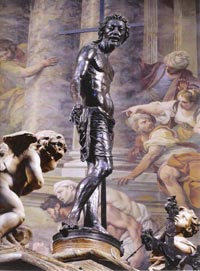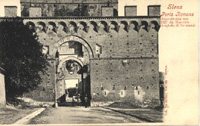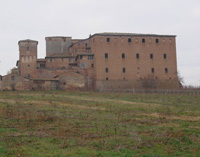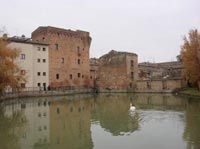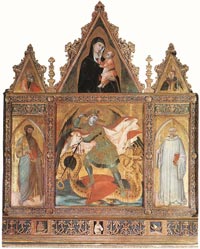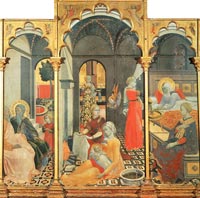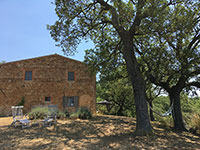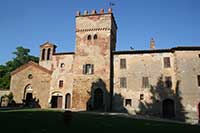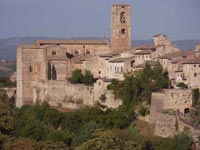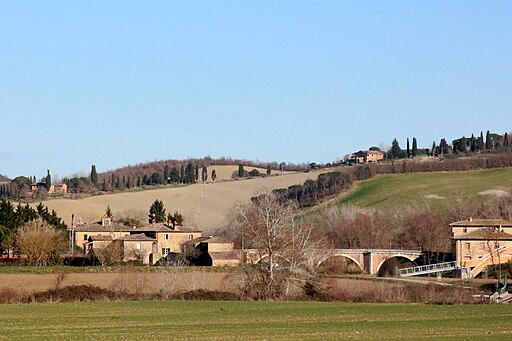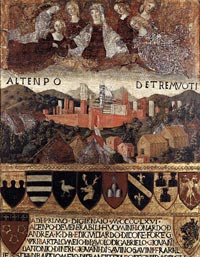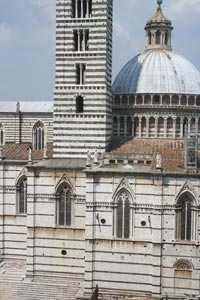The Via Francigena | From Siena to Ponte d'Arbia |
The Via Francigena unlike the Camino de Santiago in Spain is still undiscovered. |
|||
| The Via Francigena in Tuscany |
|||
Tuscany is also one of the most beautiful, but most discovered regions of Italy, but few people choose to walk through it. The ideal time to hike is from April through to October however, July and August can be hot especially further south you go. Walking in Tuscany | The Via Francigena in the Siena Region |
|||
From
Siena to Ponte d'Arbia |
|||
 |
|||
Siena, Duomo |
|||
| 12 | La Via Francigena | From
Siena to Ponte d'Arbia - 28.5 km |
||
Departure: Siena, Piazza del Campo Arrival: Ponte D'Arbia, Centro Cresti Length: 28.5 km ype of travel: On foot, by mountain bike Travel time on foot (h: min): 6.20 Getting to the starting point: Empoli-Siena-Grosseto and Siena-Chiusi railway lines, Siena or Monteroni d'Arbia station |
|||
Descrizione |
|||
| The 28.5 km leg of the Via Francigena begins in Siena and takes less than 7 hours. A challenging course along the roads of the Val d'Arbia, with rolling landscapes and views on the skyline of the city of Siena, leading to the Grancia di Cuna, an ancient fortified farm that was owned by the Santa Maria della Scala hospice. Continuing along the foothills of the Siena Crete, you pass Monteroni d'Arbia and reach Quinciano. A short distance away is the fortified town of Lucignano, with the Romanesque church of San Giovanni Battista. After a stretch along the railway line is the end of this leg in Ponte d'Arbia.[2] |
|||
Map | The Via Francigena | Siena - Ponte d'Arbia |
|||
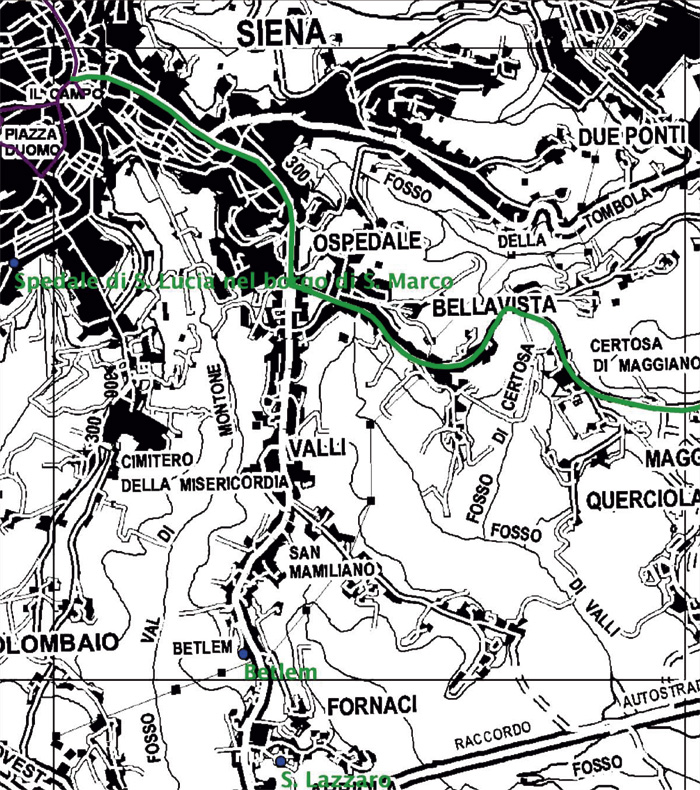 |
|||
Le cartine dettagliate del percorso si possono scaricare dal sito | www.francigena.provincia.siena.it/percorsi/tappa-12 |
|||
| The itinerary starts in the heart of the city: il Campo, the spectacular shell-shaped square where the famous Palio di Siena is held each year. You can admire the wonderful Palazzo Pubblico, whose interior is decorated with allegories by Lorenzetti and which houses the interesting Civic Museum in this square paved with the characteristic red bricks. You can also visit the huge Tower del Mangia in the square. The top is 120 meters from the ground, from where you have a wonderful view of the city. |
|||
| Siena |
|||
| At the turn of the thirteenth and fourteenth centuries, Siena reached dimensions worthy of other major urban centers of Europe at the time. The city offered to pilgrims health care and lodgings at the Hospital of Santa Maria della Scala, built in the eleventh century; it quickly became one of the largest foundations of its kind, and a large number of hotels and inns were located mostly in the Camollia and San Martino areas, located near the Via Francigena. The hospital thanks to bequests and donations received at that time had many agricultural properties, called grancie, who were in every corner of the state of Siena as in Val d'Orcia, in Val d'Arbia (Grancia of Cuna), in the Masse, in Crete Senesi and Maremma. For almost five centuries these possessions were the source of support of the Hospital of Santa Maria della Scala, until, in the second half of the eighteenth century, was ordered the sale. |
|||
| Ospedale Santa Maria della Scala |
|||
Santa Maria della Scala is located next to the city's cathedral, it is one of the most ancient European hospitals. It is now turned into a museum complex. |
|||
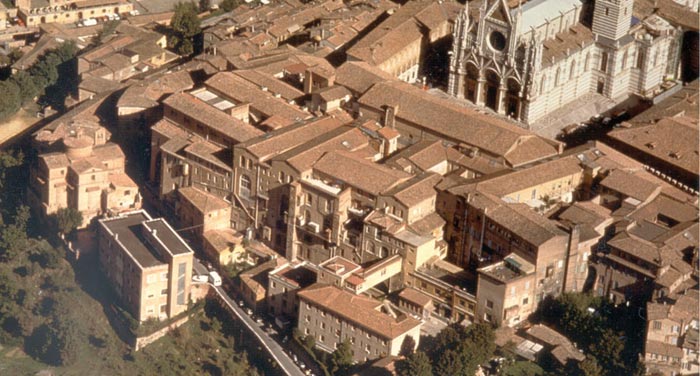 |
|||
Ospedale Santa Maria della Scala |
|||
| The most prestigious example of Sienese art in the Santa Maria della Scala complex, is the Pellegrinaio ward or 'pilgrims' hospice', built in the second half of the 14th century and decorated almost a century later with an important fresco cycle devoted to the history of the hospital. Artistic Treasures include a famous fresco cycle (now lost) with Histories of the Virgin, on the façade, by Simone Martini, Ambrogio and Pietro Lorenzetti (1335); the series of frescoes with the Stories of the Hospital in the Pellegrinaio Hall, by Domenico di Bartolo, Lorenzo Vecchietta and Priamo della Quercia, the old sacristy, also decorated by Vecchietta, the Manto Chapel, with a lunette by Domenico Beccafumi, the 15th Fonta Gaia by Jacopo della Quercia, and the decoration of the large apse by Sebastiano Conca (late 18th century). |
|||
 |
|||
Domenico di Bartolo, Pranzo dei poveri, Siena, Sala del Pellegrinaio dell'Ospitale di Santa Maria della Scala |
|||
| Domenico di Bartolo's major surviving achievement is his participation in a series of frescoes in the Pellegrinaio, the hall for pilgrims at Siena's Hospital of Santa Maria della Scala. The Frescoes have unusual secular subjects, which deal with the charitable, civic, and medical activities of the hospital. The Gothic vaulting of the room determined the arched openings. The settings are sometimes the rooms of the hospital itself. In their naturalism and their wealth of imagery drawn from contemporary life, these frescoes provide remarkable insight into Sienese activities. In the six bays of the hall, two frescoes on the east wall (The Enlargement of the Hospital; Extension of Privileges by Celestine III), and four on the north wall (Feeding of the Poor; Raising and Marrying of Orphans; Reception of Pilgrims and Distribution of Alms; Caring for the Sick) were executed by Domenico di Bartolo. The cycle was painted on four of the six 15th-century spans of the Pellegrinaio, although some traces of fresco can still be seen in the first one, probably referable to earlier paintings depicting the Storie di Tobia. These paintings were executed before 1440 by Lorenzo Vecchietta and Luciano di Giovanni da Velletri, but were later destroyed because they were deemed obsolete and unsuitable to adequately represent the history of Santa Maria, which in the meantime was acquiring growing prestige and power. The iconographic programme was conceived by rector Giovanni di Francesco Buzzichelli (1434–1444), who wanted to mark a significant change in a strongly humanistic sense, creating new compositions governed by a strict perspective, revolutionary for that time. The reference model was no longer based on religious fresco cycles on many registers, but on profane compositions that illustrated mostly cycles of chivalry or in any case, ‘civil’ histories on the walls of the representation halls of private houses or in the halls of the public buildings. This revision according to the Renaissance models was aimed at releasing the subjects of the frescoes from the religious themes and concentrate the attention on the illustration of lay myths of the foundation of the institution or on the realistic representation of the acts and works of piety that marked the daily life of the hospital. Domenico di Bartolo was a Sienese painter, some of his paintings were long attributed to his tutor, Taddeo di Bartolo. According to Vasari, although unconfirmed by other sources, he spent a period of time in Florence and had even worked in the Carmine church, where he is said to have painted the main altar (lost). He painted one of the most beautiful panels of the Early Renaissance, the Madonna dell' Umiltà. It is signed and dated 1433 and is one of the earliest truly Masaccesque paintings for which we have a firm date. In Domenico's art following the Madonna of Humility, he becomes progressively removed from Florentine examples, and in the frescoes he painted in the mid-1440s for the Pellegrinaio of the Hospital of Santa Maria della Scala in Siena he tends toward caricature and illustration. Domenico di Bartolo was the tutor of Piero della Francesca. Vecchietta was born in Castiglione d'Orcia, and lived in Siena. Much of his work may be found there, particularly at the Hospital of Santa Maria della Scala, lending him yet another name: pittor dello spedale (or 'painter of the hospital'). For the Pellegrinaio (Pilgrim Hall) at the Hospital complex, Vecchietta painted a series of frescoes, along with Domenico di Bartolo and Priamo della Quercia, including The Founding of the Spedale and The Vision of Santa Sorore, depicting a dream of the mother of the cobbler Sorore, the mythical founder of the Hospital. Later, around 1444, he created the Cappella del Sacro Chiodo, also known as the Old Sacristy, decorated with his own work. The frescoes included Annunciation, Nativity, and Last Judgment scenes, and an Allegory of the Ladder depicting children climbing to heaven. For the high altar of the Church of the Santissima Annunziata, within the Hospital complex, he created a bronze figure of the Risen Christ (signed and dated 1476), which shows the influence of Donatello. "Vecchietta's Risen Christ combines the intensity of feeling associated with medieval German sculpture with that tactile physical description that is the hallmark of Renaissance art: It is unique and -- to my mind at least -- one of the greatest works of Western sculpture.[0] Siena | Santa Maria della Scala Complesso Museale di Santa Maria della Scala Piazza Duomo, 2 Opening hours:10.30 - 18.30 |
|||
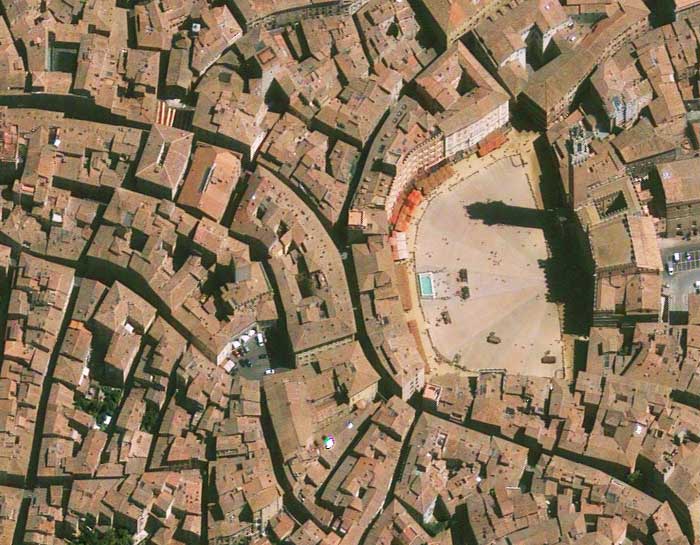 |
|||
Piazza del Campo is the principal public space of the historic center of Siena, Tuscany, Italy and is regarded as one of Europe's greatest medieval squares. It is renowned worldwide for its beauty and architectural integrity. The Palazzo Pubblico and its Torre del Mangia, as well as various palazzi signorili surround the shell-shaped piazza. |
|||
| Siena - Porta Romana |
|||
The Porta Romana, one of the old gates in the city walls of Siena, guarded the road leading to Rome. The gate was built starting in 1327. |
|||
| Chiesa di San Lazzaro dei Lebbrosi |
|||
|
|||
| Chiesa di Santa Maria in Bethlem |
|||
|
|||
| Bucciano |
|||
|
|||
| Borgovecchio |
|||
|
|||
| Santi Simone e Giuda a Colle di Malamerenda |
|||
|
|||
| Isola d'Arbia |
|||
Just outside town is the church of Sant’Ilario, which was a popular stopping point for pilgrims on their way to Rome. After about 10 kilometres there is Buonconvento, a small hamlet that was once a strategic outpost of the lands governed by the Republic of Siena. chiesetta romanica di Sant'Ilario d'Arbia |
|||
| Ponte a Tressa - S. Angelo in Tressa |
|||
|
|||
| Grancia di Cuna, a medieval fortified farm in Cuna, Monteroni d’Arbia |
|||
The village of Cuna stands along the SS2 Cassia, a few hundred meters before entering in Monteroni d' Arbia. The Grancia of Cuna is located along the ancient Via Francigena (Via Cassia), a few hundred meters north of the town of Monteroni d’Arbia. The Grancia, notable for its size, complexity and very good state of preservation, is one of the finest and rarest examples of a fortified farm from the European Middle Ages. The brick complex consists of a small village surrounded by walls with gates and towers. Within the walls is the actual farm and four storey granaries near the Palazzalti structure, which are accessed by a monumental partly covered ramp. The settlement of Cuna was formed in the 12th century starting with a series of bequests and donations, and by the 13th century was a centre within a network of manufacturing facilities and storage of agricultural products all related to the Santa Maria della Scala Hospital.
|
|||
| Monteroni d'Arbia |
Pieve of St. John the Baptist in the frazione of Corsano |
||
Monteroni d'Arbia is considered the gateway to the southern province of Siena, a beautiful area crossed by the Via Cassia. It is a small country whose development is linked to the Hospital of Santa Maria della Scala. The town of 7,161 inhabitants is 13 km from Siena and was formed in 1810, under Napoleonic rule. Until that moment, in fact, it was part of Monteroni Podesta Buonconvento. |
|
||
Taking the Cassia in the direction of Buonconvento you soon come to Lucignano d'Arbia, a fortified village where the Romanesque parish church of San Giovanni Battista frescoed in the 6th century by Arcangelo Salimbeni is well worth a visit. Setting out once more from the Cassia, the road leading to Radi follows another splendid stretch of the Crete. la Pieve di San Giovanni Battista a Lucignano d'Arbia |
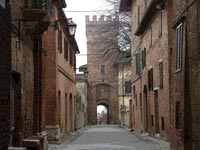 Lucignano d'Arbia |
||
Quinciano and the Cappella Pieri Nerli |
|||
Quinciano si trova su una collina fra il torrente Sorra e la via Cassia, circa 3 Km a sud di Monteroni. |
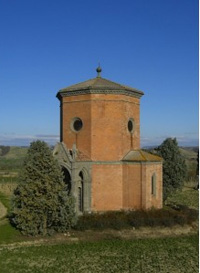 Cappella Pieri Nerli |
||
| Ponte d'Arbia |
|||
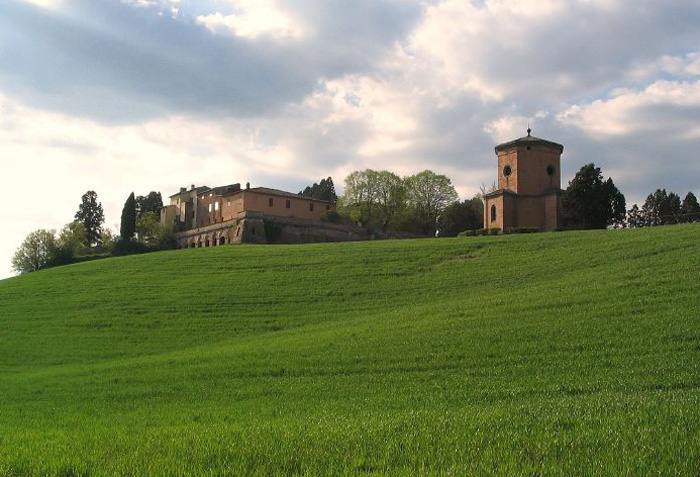 |
|||
Quinciano, Monteroni d'Arbia |
|||
La Francigena in provincia di Siena |
|||
| Guides |
|
| Trezzini, La Via Francigena. Vademecum dal Gran San Bernardo a Roma (Association Via Francigena) 2000 |
|
Guida alla Via Francigena: 900 chilometri a piedi sulle strade del pellegrinaggio verso Roma, by Monica d'Atti and Franco Cinti. (Supplemento al numero 132, aprile 2006, di "Terra di Mezzo." Piazza Napoli 30/6, 20146 Milano.) ISBN: 88-8938-565-0. |
|
| Maps |
|
| Gran parte di questo percorso della Francigena si sovrappone ai sentieri delle Crete senesi. Quindi si consiglia di premunirsi della carta escursionistica scala 1/25000: Crete Senesi –1 Val d’Arbia, edita da Multigraphic di Firenze. |
|
| Monica D’Atti & Franco Cinti, La Via Francigena. Cartografia e GPS. Dal Monginevro a Roma lungo l’itinerario storico, Milan: Terre di Mezzo Editore, 2007. ISBN: 978-88-8985-60-9 La prima e unica cartografia completa e dettagliata della Via Francigena: il percorso principale e tutte le varianti. 38 tappe, 900 chilometri a piedi, dal Monginevro a Roma, lungo il tracciato storico attraverso Piemonte, Lombardia, Emilia, Toscana e Lazio: le cartine e tutte le informazioni necessarie per orientarsi. |
|
| Download roadbook | www.camminafrancigena.it | |
| |
|
[1] |
|
| Buonconvento |
||||
Buonconvento, un tratto delle mura (sec. XIV) |
||||
Buonconvento The Museo della Val d’Arbia (Val d’Arbia Museum) has recently been opened in the centre of Buonconvento. Here, visitors will find works of art by Sano di Pietro and Matteo di Giovanni. Other sites of interest in the town include the Museo di Arte Sacra (the Museum of Sacred Art), Palazzo Ricci, the church of San Pietro e Paolo (Saint Peter and Saint Paul) and the Oratorio di San Sebastiano (the Oratory of Saint Sebastian).
The sacred art section presents works by artists such as Giovanni Pisano, Segna di Bonaventura, Ambrogio Lorenzetti, Francesco di Valdambrino, fifteenth-century panel paintings by the Osservanza Master, Pietro di Giovanni d’Ambrogio, Matteo di Giovanni e Giovanni di Paolo, and other paintings from later centuries, including the Crucifixion by Bernardino Mei, one of the leading baroque painters in Siena.
|
||||
|
||||
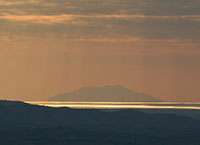 |
||||
Een authentiek vakantiehuis in de Toscaanse Maremma
|
A beautiful early evening by the pool, in the resplendent Tuscan sun, time takes on a languid quality
|
Visia da Podere Santa Pia, fino al mare e Montecristo
|
||
Badia di Sicille, Trequanda |
Colle di Val d'Elsa
|
Pienza |
||
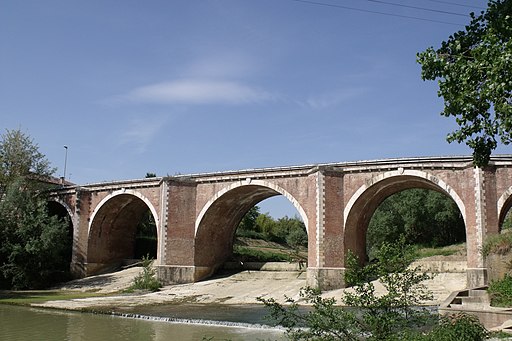 |
 |
|||
Ponte d'Arbia, frazione di Buonconvento
|
Ponte d'Arbia | Panorama of Buonconvento, Province of Siena | ||
| Siena Main sights |
||||
| Although it is difficult to identify a precise route of the Via Francigena, the stretch that crosses the province of Siena is one of the most fascinating sights of artistic and cultural as well as pristine natural areas. The historic centre of Siena has been declared by UNESCO a World Heritage Site. It is one of the nation's most visited tourist attractions, with over 163,000 international arrivals in 2008. Siena is famous for its cuisine, art, museums, medieval cityscape and the Palio, a horse race held twice a year. And it is thanks to this important road that Siena flourished in the first centuries of second millennium. Not only the Via Francigena does runs through the province of Siena from north to south; it also penetrates into the town of the Palio, in particular in the districts called Città and San Martino. Siena's cathedral (Duomo), begun in the 12th century, is one of the great examples of Italian Romanesque-Gothic architecture. Its main façade was completed in 1380. It is unusual for a cathedral in that its axis runs north-south. This is because it was originally intended to be the largest cathedral in the world, with a north-south transept and an east-west nave, as is usual.[citation needed] After the completion of the transept and the building of the east wall (which still exists and may be climbed by the public via an internal staircase) the money ran out and the rest of the cathedral was abandoned. Inside is the famous Gothic octagonal pulpit by Nicola Pisano (1266–1268) supported on lions, and the labyrinth inlaid in the flooring, traversed by penitents on their knees. Within the Sacristy are some perfectly preserved renaissance frescos by Domenico Ghirlandaio, and, beneath the Duomo, in the baptistry is the baptismal font with bas-reliefs by Donatello, Lorenzo Ghiberti, Jacopo della Quercia and other 15th century sculptors. The Museo dell'Opera del Duomo contains Duccio's famous Maestà (1308–1311) and various other works by Sienese masters. More Sienese paintings are to be found in the Pinacoteca, e.g. 13th century works by Diotisalvi di Speme. The shell-shaped Piazza del Campo, the town square, which houses the Palazzo Pubblico and the Torre del Mangia, is another architectural treasure, and is famous for hosting the Palio horse race. The Palazzo Pubblico, itself a great work of architecture, houses yet another important art museum. Included within the museum is Ambrogio Lorenzetti's series of frescos on the good government and the results of good and bad government and also some of the finest frescoes of Simone Martini and Pietro Lorenzetti. On the Piazza Salimbeni is the Palazzo Salimbeni, a notable building and also the medieval headquarters of Monte dei Paschi di Siena, one of the oldest banks in continuous existence and a major player in the Sienese economy. Housed in the notable Gothic Palazzo Chigi on Via di Città is the Accademia Musicale Chigiana, Siena's conservatory of music. Other churches in the city include: Basilica dell'Osservanza, Santa Maria dei Servi, San Domenico, San Francesco, Santo Spirito and San Martino. Sanctuary of Santa Caterina, incorporating the old house of St. Catherine of Siena. It houses the miraculous Crucifix (late 12th century) from which the saint received her stigmata, and a 15th century statue of St. Catherine. The city's gardens include the Orto Botanico dell'Università di Siena, a botanical garden maintained by the University of Siena. The Medicean Fortress houses the Enoteca Italiana and the Siena Jazz School, with courses and concerts all the year long and a major festival during the International Siena Jazz Masterclasses. Over two weeks more than 30 concerts and jam sessions are held in the two major town squares, on the terrace in front of the Enoteca, in the gardens of the Contrade clubs, and in numerous historical towns and villages of the Siena province. Siena is also home of Sessione Senese per la Musica e l'Arte (SSMA), a summer music program for musicians, is a fun/learning musical summer experience. In the neighbourhood are numerous patrician villa, numerous of which attributed to Baldassarre Peruzzi: Villa Chigi, Castle of Belcaro, Villa Celsa, Villa Cetinale and Villa Volte Alte. Siena | Palazzo Pubblico Siena | Duomo |
|
|||
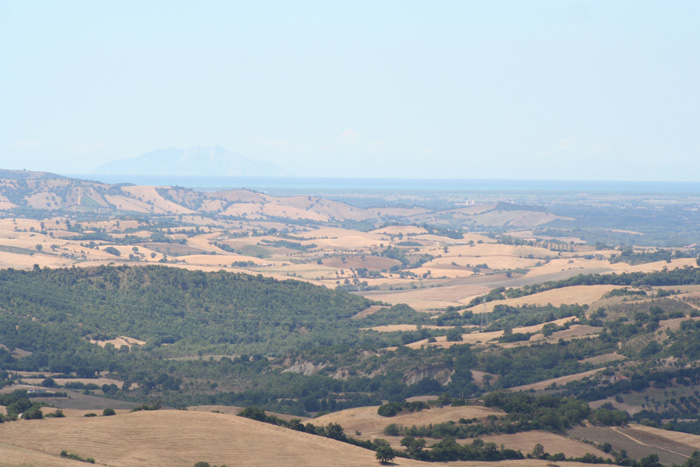 |
||||
Podere Santa Pia, with its wide panoramic terrace overlooking the Maremma and Monte Christo (August) |
||||
This article incorporates material from the Wikipedia articles Siena, (Siena) published under the GNU Free Documentation License. |
||||


